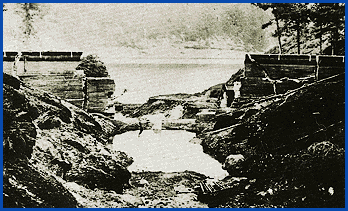
The Dambusters connection
The destruction of Nant-y-Gro
dam
The Nant-y-Gro experiments were preceded by trials on scale models at government research stations near London, involving the detonation of scaled amounts of explosives at varying distances from the walls of the model dams. In May 1942 the first live explosive tests on the dam itself were carried out in the Elan Valley, watched by Barnes Wallis. These first attempts were spectacular, but they did not seriously damage the Nant-y-Gro dam.
Elan Valley,
July 1942
 The
photograph shown here records the effect of the test detonation
of explosives in direct contact with the dam wall, as viewed
from the upstream side.
The
photograph shown here records the effect of the test detonation
of explosives in direct contact with the dam wall, as viewed
from the upstream side.Caban Coch reservoir can be seen beyond the remains of the Nant-y-Gro dam.
The location of
the Elan Valley dams
and reservoirs
is shown on the
sketch map.
After further development work, another attempt was made in
July 1942. A mine was suspended at the optimum depth by scaffolding
from the mid point of the 180 feet long dam, and detonated remotely.
A huge central section of the dam wall was successfully blasted
away in a massive explosion.
This successful trial confirmed that it would be necessary to
deliver an explosive device under water and in direct contact
with a dam wall in order to do the job. It was known that all
major dams would be safeguarded by protective netting positioned
to prevent mines or torpedoes from reaching them, so the Elan
Valley tests were followed by an extensive programme of highly
secret trials at other locations in Britain which were to result
in the famous ‘bouncing bomb’ devised by Barnes Wallis.
There are 4 pages on the Dambusters connection. Use the box links below to view the other pages.